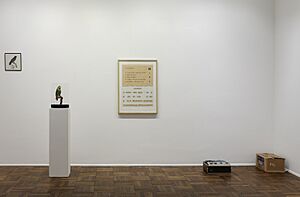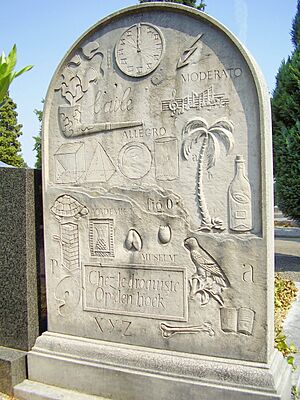Marcel Broodthaers facts for kids
Quick facts for kids
Marcel Broodthaers
|
|
|---|---|
| Born |
Marcel Broodthaers
28 January 1924 Brussels, Belgium
|
| Died | 28 January 1976 (aged 52) |
| Nationality | Belgian |
| Known for | Film, poetry, sculpture, artist's book, Installation |
|
Notable work
|
Un Coup de Dés Jamais N'Abolira Le Hasard, 1969 |
| Movement | Conceptual Art |
Marcel Broodthaers (born January 28, 1924 – died January 28, 1976) was a talented artist from Belgium. He was a poet, a filmmaker, and a visual artist. He is known for his unique and thoughtful artworks that often made people think about art itself.
Contents
Early Life of Marcel Broodthaers
Marcel Broodthaers was born in Brussels, Belgium, on January 28, 1924.
Marcel Broodthaers' Artistic Journey
From 1945, Broodthaers was part of a group called the Groupe Surréaliste-revolutionnaire.
Becoming an Artist
For 20 years, Marcel Broodthaers was a poet who struggled financially. At the end of 1963, he decided to become a visual artist. He started making art objects. His first art piece was made by putting 50 unsold copies of his poetry book, Pense-Bête, into plaster.
In 1964, for his first art show, he wrote a famous introduction. It was printed on pages cut from magazines. This also served as the announcement for his exhibition. He wrote:
"I, too, wondered whether I could not sell something and succeed in life. For some time I had been no good at anything. I am forty years old... Finally the idea of inventing something insincere crossed my mind and I set to work straightaway. At the end of three months I showed what I had produced to Philippe Edouard Toussaint, the owner of the Galerie St Laurent. 'But it is art' he said 'and I will willingly exhibit all of it.' 'Agreed' I replied. If I sell something, he takes 30%. It seems these are the usual conditions, some galleries take 75%.
What is it? In fact it is objects."
This quote shows how he thought about art and selling it.
Artworks and Installations
Broodthaers often used everyday items and collage in his art. He frequently included written words in his pieces. He used whatever he could find, like eggshells, mussel shells, furniture, clothes, and garden tools.
- In his work Visual Tower (1966), he built a tall, circular wooden tower. Each of its seven levels was filled with glass jars. In every jar, he placed the same picture of a young woman's eye from a magazine.
- For Surface de moules (avec sac) (Surface of mussels (with bag)) (1966), he glued mussels onto a square panel. Later, he added a hook to hold a shopping bag full of mussel shells.
From 1968 to 1975, Broodthaers created large art installations. These pieces changed how people thought about museums.
The Museum of Modern Art, Department of Eagles
One of his most famous works was an installation that started in his own house in Brussels. He called it Musée d'Art Moderne, Départment des Aigles (Museum of Modern Art, Department of Eagles) (1968). This installation featured different images of eagles in glass cases. Next to them were signs that said, "This is not a work of art." This made people think about how museums decide what is art and what is not.
This "museum" was shown in eleven other places, including the Kunsthalle Düsseldorf in 1970 and documenta 5 in Kassel in 1972. In 1970, Broodthaers even tried to "sell" his museum because it was "bankrupt." He announced this sale on the cover of the Art Cologne fair catalog in 1971, but no one bought it.
As part of this "Financial Section," he also made gold bars stamped with the museum's eagle symbol. Eagles often represent power and victory. These gold bars were sold to raise money for the museum. Their price was double the market value of gold, with the extra cost being for their value as art.
Later Installations
In 1974, Broodthaers opened three different exhibitions in the same week. Each show featured a new type of installation he called "décors." These were shown in Antwerp, Brussels, and Basel.
In 1975, he presented "L’Angelus de Daumier" in Paris. Each room in this exhibition was named after a color. In La Salle Blanche (The White Room) (1975), he recreated a part of his Brussels home. The wooden walls of these empty rooms were covered with French words like "museum," "gallery," and "images." This work explored how language affects how we see the world and how museums influence art.
Because of works like these, Broodthaers is linked to installation art and "institutional critique." This means he made art that questioned the relationship between artworks, artists, and museums. His Musée d'Art Moderne allowed him to act as an artist, director, and curator all at once. He used this to examine the rules and ideas behind museum exhibits. In 2019, The New York Times called Musée d'Art Moderne, Départment des Aigles one of the 25 artworks that defined the modern age.
Films by Broodthaers
Broodthaers made his first film in 1957. From 1967, he created over 50 short films. These films were documentaries, stories, and experimental pieces. He worked with Belgian director Jean Harlez, who filmed many of his movies.
Publishing and Printed Works
As a poet and activist, Broodthaers was always interested in how printed materials could spread ideas. This included posters, graphics, and artist books. He published books with art institutions like Kunsthalle Düsseldorf and the Museum of Modern Art, Oxford. These books mixed his ideas about making money with his artistic and philosophical thoughts.
For example, his catalog for Der Adler von Oligizän bis heute (The Eagle from the Oligocene to Today) was published in two parts. This was the main work from his Musee d'Art Moderne, department des Aigles show in 1972. Volume I was sold at the exhibition opening and had a coupon for Volume II. Volume II, which showed pictures of the installation, came out after the exhibition closed.
Broodthaers used this idea again for his artist's book Photographieren Verboten/No Photographs Allowed. He played with the usual layout of an exhibition catalog. The first version was published in Berlin, and the second in Oxford. The Oxford book had the same content but mixed up the order. For example, the artist's resume, usually at the back, appeared on the front cover as a pattern. Scholarly essays, usually inside, were on the back cover like an advertisement. This made people think about how books are put together and what each part means.
Later Life and Passing
From late 1969, Broodthaers lived mostly in Düsseldorf, Berlin, and finally London.
He passed away on January 28, 1976, in Cologne, Germany. He died from a liver disease on his 52nd birthday. He is buried at Ixelles Cemetery in Brussels. His tombstone was designed by him and created by sculptor Karel Van Roy.
Exhibitions of Marcel Broodthaers' Work
Marcel Broodthaers' art has been shown in many important exhibitions around the world.
- In 1980, the Tate Gallery in London held an exhibition called "Marcel Broodthaers."
- Other major shows of his work have been at the Walker Art Center (1989), Museum of Contemporary Art, Los Angeles (1989), Carnegie Museum of Art, Pittsburgh (1989), Jeu de Paume, Paris (1991), and Palais des Beaux Arts, Brussels (2000).
- More recently, his work was shown at The Fridericianum, Kassel, Germany (2015), and Muhka, Antwerp (2019).
- A traveling exhibition was organized by the Museum of Modern Art, New York, and the Museo Nacional Centro de Arte Reina Sofía, Madrid, in 2016. It then went to the Kunstsammlung Nordrhein-Westfalen, Düsseldorf, in 2017.
- A special exhibition focusing on his films, "Marcel Broodthaers: Cinéma," was shown in Spain and Germany in 1997.
His work has also been part of many important group exhibitions, including documenta 5, 7, and 10 in Kassel (1972, 1982, and 1997). A recent group show was The Artist as Poet: Selections from Pamm's Collection at the Pérez Art Museum Miami in 2021-2022.
See also
 In Spanish: Marcel Broodthaers para niños
In Spanish: Marcel Broodthaers para niños



